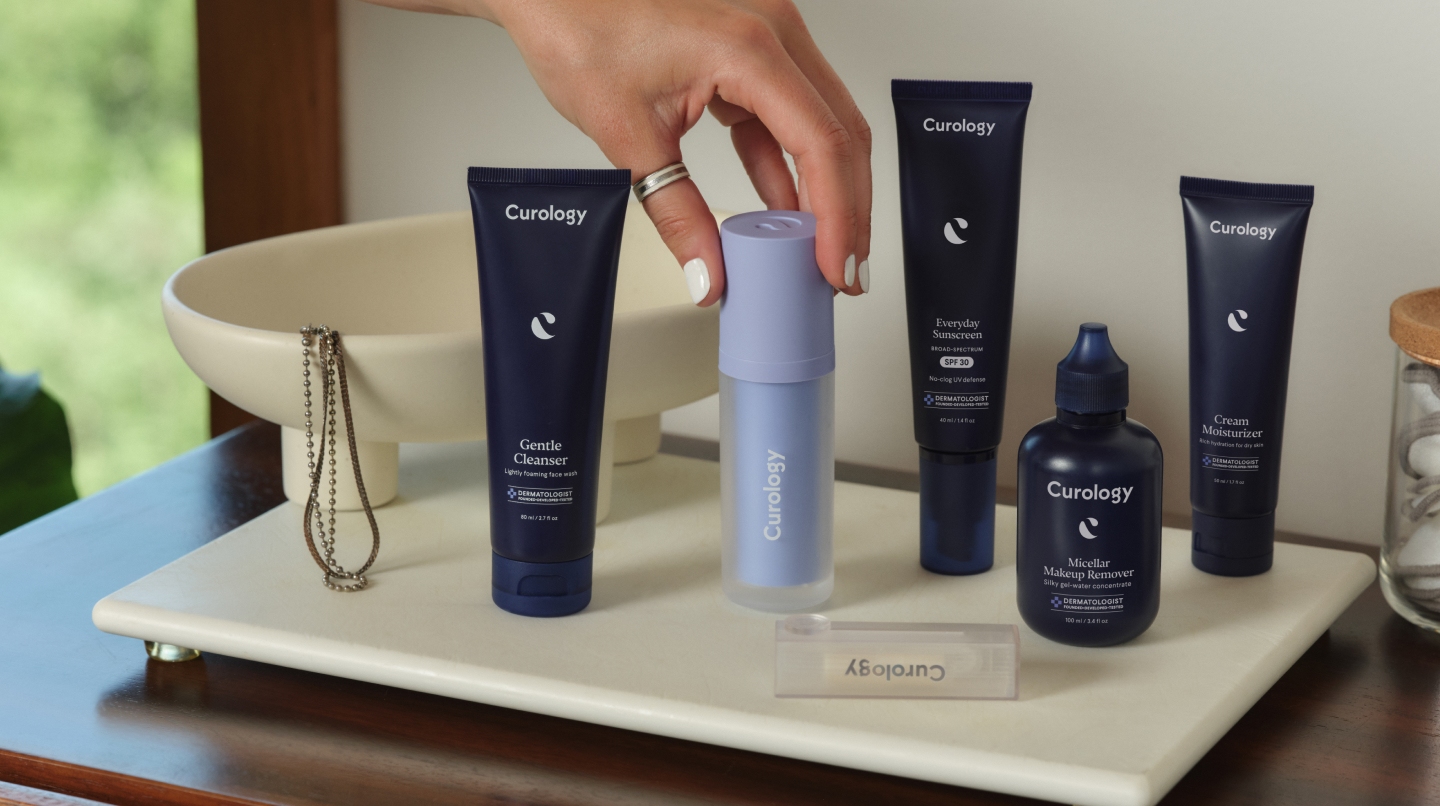How it works:
Share your skin goals and snap selfies
Your dermatology provider prescribes your formula
Apply nightly for happy, healthy skin
How it works:
How it works:
Share your skin goals and snap selfies
Your dermatology provider prescribes your formula
Apply nightly for happy, healthy skin
How it works:
What causes back acne and how to help clear it up
What to do about annoying cysts on your back.



Did you know acne can happen not only on the face but elsewhere on the body? It can pop up anywhere, including the shoulders, back, and chest. If you’ve experienced body acne, don’t worry; it's very common, and many people have dealt with it at some point in their life. Back acne—aka “bacne”—is especially common, and you might even experience inflammatory acne in the form of cysts. So, what’s the deal with body acne? How does it happen, and how can you get rid of it?
What causes cystic acne on the back?
Cystic acne—or any type of acne, for that matter—on your back is caused by the same contributing factors that lead to acne vulgaris on your face (vulgaris means “common” in Latin). Acne vulgaris is a term that refers to breakouts that involve more than one type of acne lesion. Factors that contribute to breakouts include:
Excess oil production. Skin naturally produces oil, called sebum, in the sebaceous glands. But overproduction of sebum is one factor that can lead to clogged pores and acne.¹
Dead skin cells. A build-up of excess dead skin cells can combine with sebum in hair follicles, which can also lead to clogged pores and acne.
Bacteria. C. acnes, the bacteria that contributes to acne, thrives in the excess sebum and leads to inflammation when the body’s immune system reacts to fight off the bacteria.
There are several different types of acne, each with its own characteristics and ways of treating and helping to prevent it.² Knowing what type of pimple or pimples you have can help you find the right acne treatment for you.
Whiteheads and blackheads are comedones. They are pores that are blocked with sebum and dead skin cells.
Papules and pustules are both inflammatory acne lesions. Papules are small red bumps, and pustules are filled with pus.
Nodules are hard inflammatory acne lesions that are deep in the skin.
Cysts are pus-filled inflammatory acne lesions. They may be painful and can lead to scarring.
What are some common causes of cystic acne on the back?
If you’re experiencing back acne and wondering if it has a specific cause, here are a few scenarios that can increase your chances of back breakouts.
Tight workout clothes. If you wear close-fitting clothes when working out, friction combined with sweat can contribute to acne breakouts.³
Sports gear. Like tight workout clothes, if you use athletic equipment (football shoulder pads, for example) that frequently rubs your back, friction and sweat can also contribute to breakouts.
Harsh products. This might sound counterintuitive, but if your attempts to zap blemishes involve using products with potent active ingredients, they may irritate your skin. Irritated skin is more likely to break out.⁴
Comedogenic ingredients. Products with comedogenic ingredients can clog your pores, leading to blemishes. These often unassuming culprits could be lurking in your body wash, skincare or haircare products. Be sure to look for products that are labeled non-comedogenic to help prevent back acne.⁵
Hormones. Your hormones can contribute to your breakouts. Excess androgens, a type of hormone, for instance, have been linked to acne. Hormonal fluctuations either around puberty or with menstrual cycles can contribute to acne flare-ups.⁶
Genetics. You might be breaking out due to your family history. If that’s the case, don’t panic; many acne treatments are still effective.⁷
Stress. Stress isn’t a direct cause of acne, but it can indirectly contribute to breakouts.⁸ We understand that you can't help getting stressed every now and then, but remember to prioritize your self-care. That could look like going on a walk, taking deep breaths, or regularly pausing in a quiet moment to enjoy your favorite tea, all in the effort of keeping stress at bay.
How can you help prevent cystic back acne?
Cystic acne isn’t always the easiest to treat, and it can come with a greater risk of scarring compared to other types of acne. But if you want to prevent future breakouts, there are some concrete steps you can take that may help prevent cystic acne on your back. Let's look at how to get rid of cystic acne on the back and keep future breakouts away in general.
Target body acne with body acne-fighting products. The Curology acne body wash is designed to clear pores and help treat and prevent acne. The best part? You can seamlessly work it into your body care routine by using it when you shower. We also recommend zinc pyrithione soap because it helps get rid of that acne-causing pityrosporum fungus that lives on the skin. Just make sure you give the zinc time to sink into your skin by leaving the soap suds on your skin for a minute before rinsing it off.
Cut out the sweaty workout clothes. Working up a sweat is great for the body, but don’t let tight, sweaty clothes linger on your skin for too long afterward. Once you finish your workout, remember to remove your gear and wash your skin as soon as possible to help keep your pores clear.
Use non-comedogenic products. Remember to check your bath and skincare products—body washes, shampoos, body lotions—for pore-clogging ingredients and switch to non-comedogenic products if necessary.
Opt for gentle products. If you’re using products with harsh active ingredients to treat and help prevent cystic acne, they could actually be irritating your skin and contributing to your breakouts instead.
Remember to moisturize. If you’re using an acne body wash or topical acne treatment, be sure to replenish and moisturize your skin. Find a great non-comedogenic moisturizer to add to your routine to keep your skin happy.
Speak with a professional. Your medical provider may be able to offer topical or oral prescription medications that are stronger than over-the-counter treatments to help fight cystic back acne.
Here are a few prescription options a medical provider may prescribe or recommend.
Isotretinoin. Isotretinoin is an oral medication, formerly called Accutane, often used to treat severe cystic acne.⁹
Spironolactone. This oral medication can be used to treat hormonal acne.
Oral contraceptives. Oral contraceptives may be prescribed to alleviate hormonal acne.
Oral antibiotics. Oral antibiotics are another treatment option commonly used to address persistent breakouts.
Steroid injections. If you have a particularly inflamed cyst, a medical professional may use a steroid injection to help reduce inflammation.¹⁰
The simple solution
Cystic acne on the back—or anywhere for that matter—can be frustrating, but remember, acne is very common and affects adults as well as adolescents. The good news is plenty of treatment options are available, so it’s just a matter of finding the one that works best for your unique skin. That’s where Curology comes in!
When it comes to skincare, Curology has your back—literally. With Curology, you get custom skincare products delivered right to your door. Curology members are paired with one of our licensed dermatology providers to help guide you on your skincare journey. We’re here to make skincare simple and effective.
Get your personalized skincare routine with Curology
Get your personalized skincare routine with Curology


To try Curology, just take a quick skin quiz and snap a few selfies to get paired with a dermatology provider. We’ll take a look at your skin and, if Curology is right for you, send a Custom Formula with a mix of active ingredients chosen for your unique skin directly to your door—for free* (you’ll just cover $4.95 for shipping and handling), and you can try any of our recommended skincare products at no extra cost. As an online skincare service, we’re all about making medical-grade skincare accessible to everyone, no matter where you call home.
FAQs
Factors that contribute to breakouts include:
Excess oil production. Overproduction of sebum is one factor that can lead to clogged pores and acne.
Dead skin cells. Excess dead skin cells can combine with sebum in hair follicles, which can also lead to clogged pores and acne.
Bacteria. C. acnes, the bacteria that contributes to acne, thrives in the excess sebum and leads to inflammation when the body’s immune system reacts to fight off the bacteria.
Tight workout clothes. Friction combined with sweat can contribute to acne breakouts.
Sports gear. Like tight workout clothes, that frequently rub your back, friction and sweat can also contribute to breakouts.
Harsh products. Using products with potent active ingredients may irritate your skin.
Comedogenic ingredients. Products with comedogenic ingredients can clog your pores, leading to blemishes.
Hormones. Your hormones can contribute to your breakouts. Excess androgens, a type of hormone, for instance, have been linked to acne.
Genetics. You might be breaking out due to your family history. If that’s the case, don’t panic; many acne treatments are still effective.
Stress. Stress isn’t a direct cause of acne, but it can indirectly contribute to breakouts. Remember to prioritize your self-care.
Target body acne with body acne-fighting products. The Curology acne body wash is designed to clear pores and help treat and prevent acne. We also recommend zinc pyrithione soap because it helps get rid of that acne-causing pityrosporum fungus.
Cut out the sweaty workout clothes. Don’t let tight, sweaty clothes linger on your skin for too long afterward.
Use non-comedogenic products. Remember to check your bath and skincare products for pore-clogging ingredients and switch to non-comedogenic products if necessary.
Opt for gentle products. If you’re using products with harsh active ingredients to treat and help prevent cystic acne, they could be contributing to your breakouts instead.
Remember to moisturize. If you’re using an acne body wash or topical acne treatment, be sure to replenish and moisturize your skin.
Speak with a professional. Your medical provider may be able to offer topical or oral prescription medications.
P.S. We did the research so you don’t have to:
Sutaria, A. H., et al. Acne Vulgaris. In StatPearls. StatPearls Publishing. (2022).
Cleveland Clinic. Acne. (2020, September 1).
Mills, O. H., Jr, & Kligman, A. Acne mechanica. Archives of dermatology. (April 1975).
American Academy of Dermatology.10 skin care habits that can worsen acne.(n.d.).
American Academy of Dermatology.10 skin care habits that can worsen acne. Ibid.
Elsaie M. L. Hormonal treatment of acne vulgaris: an update. Clinical, cosmetic and investigational dermatology. (2016).
Di Landro A, et al. Family history, body mass index, selected dietary factors, menstrual history, and risk of moderate to severe acne in adolescents and young adults. J Am Acad Dermatol. ( December 2012)
Cleveland Clinic. Acne. Ibid.
Zaenglein, A. L., et al. Guidelines of care for the management of acne vulgaris. Journal of the American Academy of Dermatology. (2016).
Cleveland Clinic. Acne. Ibid.
* Subject to consultation. Subscription is required. Results may vary.

Curology Team

Allison Buckley, NP-C
Related Articles
The best men’s body washes, according to expertsWhat causes acne keloidalis nuchae? Does creatine cause acne? Here’s what the science saysHow to choose the best body wash for sensitive skinHow to treat armpit pimples and bumpsPopular Articles
Ask Curology: Is my cold breaking me out?Slugging: The dermatologist-approved skincare hack going viral on TikTokTretinoin vs retinol: What’s the difference?How to create a self-care routine that actually sticksYour 2023 skincare horoscopeTry prescription skincare
Get routine essentials

Good skin days ahead
- Breakouts
- Redness
- Fine lines
- Dark spots
- Hair thinning